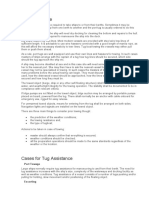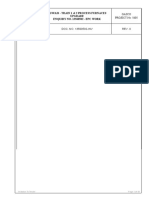Watercraft and Dredging: October 2009 28-1
Watercraft and Dredging: October 2009 28-1
Uploaded by
Aly ShahCopyright:
Available Formats
Watercraft and Dredging: October 2009 28-1
Watercraft and Dredging: October 2009 28-1
Uploaded by
Aly ShahOriginal Title
Copyright
Available Formats
Share this document
Did you find this document useful?
Is this content inappropriate?
Copyright:
Available Formats
Watercraft and Dredging: October 2009 28-1
Watercraft and Dredging: October 2009 28-1
Uploaded by
Aly ShahCopyright:
Available Formats
Section 28
Watercraft and Dredging
This section sets forth the requirements for watercraft and dredging. The
requirements for actual watercraft and dredging equipment are discussed, as well
as the requirements for personnel performing such watercraft and dredging
operations. Inspection, training, certification, and various operating activities are
discussed in detail.
28.1 General Requirements for Watercraft Operations
28.1.1 Requirement. Construct all watercraft and perform all watercraft
operations according to the requirements of these standards, as well as
applicable U.S. Coast Guard (USCG), Department of the Interior, State, and
local requirements.
28.1.2 Inspection and Certification. Inspect, certify, license, and number
all watercraft and equipment according to applicable regulations of USCG and
other jurisdictional entities before placing them in service.
28.1.3 Capacity Plates. Plainly mark on all watercraft the maximum
occupancy and carrying capacity allowed onboard for safe passage (i.e.,
USCG maximum capacities). Do not exceed this maximum occupancy or
carrying capacity.
28.1.4 Loading. Make sure each boat has enough room, freeboard, and
stability to safely carry the maximum cargo and passengers under various
weather and water conditions.
28.1.5 Flame Arresters. Equip gasoline engines, except for outboard types,
with a USCG-approved backfire flame arrestor. Make sure the arrestor is
attached to the air intake with a flame-tight connection. It must be kept clean
and in serviceable condition.
28.1.6 Fire Extinguishers. For watercraft less than 65 feet in length, at least
one USCG-approved fire extinguisher, rated 2-A:40-B:C or greater, must be
carried onboard. Watercraft 65 feet or larger must carry sufficient fire
extinguishers to meet USCG requirements. Watercraft with gasoline or liquid
petroleum gas powerplants located in a compartment or confined location
must have a fixed automatic carbon dioxide (or equivalent) fire-extinguishing
system.
28.1.7 Ventilation. Watercraft with permanently installed gasoline engines
must have powered ventilation systems to remove gasoline vapors from the
vessel.
October 2009 28-1
Reclamation Safety and
Health Standards
28.1.8 Fuel. Store fuel in approved containers suitable for marine use. Fuel
lines must be equipped with a valve to cut off fuel flow. In addition, if the
watercraft will not be in use for a period of 8 hours or longer, then the valve
must be closed.
28.1.9 Navigation Lights. Watercraft must be able to display navigation
lights required by USCG. Display navigation lights between sunset and
sunrise and any other time visibility is reduced (fog, haze, rain, etc.).
28.1.10 Operator Training and Qualification. Reclamation employees and
others who operate a Reclamation-owned watercraft must first be certified or
licensed to operate watercraft in accordance with DOI 485 DM 22. Non-
Reclamation employees who operate watercraft owned by others must be
qualified in accordance with USCG, State, and local regulations.
28.1.11 Float Plans. If the operator expects watercraft activities to take
longer than 4 hours from time of departure until time of return, a float plan
must be prepared. The float plan must include the following information:
• Watercraft information (vessel make/model or local identifier)
• Personnel onboard
• Activity to be performed
• Expected time of departure, route, and time of return
• Means of communication (if any)
28.1.12 Personal Flotation Devices (PFD) Equip watercraft with one
USCG-approved PFD for each occupant, and once USCG-approved throwable
device onboard the watercraft. Wear a PFD whenever you are onboard a
watercraft or working around bodies of water where a drowning hazard exists.
Refer to the section on "Personal Protective Equipment."
28.1.13 Safety Equipment. Equip all watercraft with adequate safety
equipment to meet USCG requirements and any hazards that may be
encountered during normal operations.
28.1.14 Swimming. You must not swim from watercraft or any floating
equipment unless you are a certified diver whose duties require such
swimming.
28.2 Dredging Operations
28.2.1 Inspections. A qualified person must inspect dredges and related
equipment before they are entered into service, and at least yearly thereafter,
to make sure they are in safe operating condition. The inspector must have a
recognized degree, certificate, or license, or professional standing, as well as
extensive knowledge, training, and experience in solving problems related to
the work. Inspections must be documented and accessible to personnel.
28-2 October 2009
Section 28—Watercraft and
Dredging
28.2.2 Maintenance and Repair. Before performing repair or maintenance
work on the pump, suction, or discharge lines below the water line, or within
the hull, in addition to the normal process of securing hoisting machinery, you
must raise the ladder (or drag arm) above the water line and positively secure
it. Set blank or block plates in suction or discharge lines as appropriate. Also
see the section on "Control of Hazardous Energy (Lockout/Tagout)."
28.2.3 Pipeline Marking. Dredge pipelines that float or are supported on
trestles must display appropriate lights at night and when visibility is
restricted, in accordance with USCG regulations and 33 CFR 88.15.
28.2.4 Public Notification. Issue public notices where dredging activity may
pose hazards to navigation or to the public.
28.2.5 Safety Plans. Prepare a comprehensive safety plan for each dredging
operation. Make the plan location specific and include provisions for
communications and emergency response.
28.2.6 Submerged Dredge Pipeline
a. Where a pipeline crosses a navigation channel or other area subject to
boat traffic, submerged pipeline must rest on the channel bottom. The top
of the pipeline and any anchor securing the pipe must be no higher than
the maximum draft of traffic expected in the area where pipe is placed.
b. When buoyant or semibuoyant pipeline is used, the dredge operator
must make sure the pipeline remains fully submerged and on the bottom.
When raising the pipeline, warn boat traffic of the pipeline hazard.
Adequately mark the entire length of the pipeline as required by the
USCG.
c. Mark the entire location of the submerged pipeline with signs, buoys,
lights, or flags as required by USCG and as approved by the authority
having jurisdiction.
d. Conduct routine inspections of the submerged pipe to ensure
anchorage.
e. Remove all anchors and related materials when removing the
submerged pipe.
28.2.7 Floating Pipeline. Floating pipeline is any pipeline not anchored on
the channel bottom. Clearly mark floating pipeline, including rubber
discharge hoses. Do not allow pipelines to fluctuate between the water
surface and the channel bottom or to lie partially submerged.
a. If floating pipelines are used as accessways, equip them with a
walkway and handrail on one side. Personnel using the walkway or
working on the pipeline must wear an approved PFD.
October 2009 28-3
Reclamation Safety and
Health Standards
28.2.8 Dredge Design. Design dredges so that a failure or rupture of any of
the dredge pump components (including dredge pipe) will not cause the
dredge to sink.
a. Dredge Pumps. Any dredge with a dredge pump below the water line
must have a bilge alarm or automatically shut down in the event of a pump
leak.
b. Fall Protection. Provide guardrails, bulwarks, or taut cable guard
lines for deck openings, elevated surfaces, or other locations where a
person may slip or fall from them. Guardrails and taut cable guard lines
must comply with the requirements for standard guardrails.
c. Walking and Working Surfaces
1. Provide anti-slip surfaces on all working decks, stair treads, vessel
ladders, and other walking or working surfaces that may become wet
during operations.
2. Remove obstructions in walking and working surfaces if possible.
Where obstructions cannot be removed, post appropriate warning signs
or distinctively mark them in accordance with section 9 and
ANSI Z535.1.
3. Where the distance between the vessel and docks or landings
exceeds 18 inches horizontal or 12 inches vertical, provide gangways.
Gangways must be at least 22 inches wide, with standard railings, and
be able to support 250 pounds (with a safety factor of 4:1) at its
midpoint.
28.2.9 Relocation. A qualified person must directly supervise any
mobilization, demobilization, or relocation of dredges, support barges, or
other support equipment.
28-4 October 2009
You might also like
- Living On One Dollar Movie Guide QuestionsDocument3 pagesLiving On One Dollar Movie Guide QuestionsSkye BrownNo ratings yet
- Bridge Watch Keeping, Best PracticeDocument40 pagesBridge Watch Keeping, Best PracticeRafi Muiz100% (8)
- Gangway Installation ProcedureDocument8 pagesGangway Installation ProcedureAnonymous i3lI9M100% (2)
- 2009 IMO MODU Code AmendmentsDocument9 pages2009 IMO MODU Code AmendmentsPraveen Balachandran100% (1)
- Piloting, Seamanship and Small Boat Handling - Vol. VFrom EverandPiloting, Seamanship and Small Boat Handling - Vol. VRating: 5 out of 5 stars5/5 (2)
- Safety On TugsDocument7 pagesSafety On TugsFaidzy BinNo ratings yet
- MSC.1-Circ.1327-Guidelines For The Fitting and Use of Fall Prevention Devices (FPDS)Document6 pagesMSC.1-Circ.1327-Guidelines For The Fitting and Use of Fall Prevention Devices (FPDS)CaptShivraj ManeNo ratings yet
- Gangway Installation ProcedureDocument8 pagesGangway Installation Procedurelon way100% (1)
- Water and IceDocument4 pagesWater and IcegregNo ratings yet
- Master KaptanlıkDocument42 pagesMaster KaptanlıkCelal Bozdogan100% (1)
- Hserm D Off SHR PDF CompleteDocument29 pagesHserm D Off SHR PDF Completecrni rokoNo ratings yet
- SOLAS Oral FinalDocument16 pagesSOLAS Oral FinalAlamgir Hossain SaikatNo ratings yet
- MGN 464Document8 pagesMGN 4641020025288No ratings yet
- 8 6 8Document6 pages8 6 8sonerNo ratings yet
- Stability Past Paper TheoryDocument164 pagesStability Past Paper TheoryazharNo ratings yet
- LRLayupGuideNov091.pdf 11 15Document5 pagesLRLayupGuideNov091.pdf 11 15Cip GrecuNo ratings yet
- LB and RB Disengaging Gears and Similar ArrangementsDocument8 pagesLB and RB Disengaging Gears and Similar ArrangementsNAZIM ŞAHAN ERKALNo ratings yet
- IACS Rec.39 Rafting#1Document3 pagesIACS Rec.39 Rafting#1AndyNgoNo ratings yet
- Msn010lifeboatrecoverystrops PDFDocument6 pagesMsn010lifeboatrecoverystrops PDFVinoth RubanNo ratings yet
- Towage Planning and Notification RequirementsDocument5 pagesTowage Planning and Notification RequirementsSeaworks CompanyNo ratings yet
- DP GuidelinesDocument6 pagesDP GuidelinesRafael Lucas TeixeiraNo ratings yet
- ANNEX C Overwater Annd Shiboard Ops v2.1Document11 pagesANNEX C Overwater Annd Shiboard Ops v2.1sma.ismaelNo ratings yet
- Imo Rules Submersible VehiclesDocument24 pagesImo Rules Submersible VehiclesMerrelNo ratings yet
- MGN XXX (M+F) : Lifeboat: Fitting of 'Fall Preventer Devices' To Reduce The Danger of Accidental On-Load Hook ReleaseDocument7 pagesMGN XXX (M+F) : Lifeboat: Fitting of 'Fall Preventer Devices' To Reduce The Danger of Accidental On-Load Hook ReleaseejassssNo ratings yet
- Bridge Watchkeeping SolvedDocument23 pagesBridge Watchkeeping Solvedsahilakram895No ratings yet
- Hatch Cover Maintenance PlanDocument5 pagesHatch Cover Maintenance Planvinay3972No ratings yet
- Ready Availability of Towing ArrangementsDocument4 pagesReady Availability of Towing ArrangementshgmNo ratings yet
- Anchoring, Mooring/BerthingDocument13 pagesAnchoring, Mooring/BerthingLiviu VladNo ratings yet
- Chapter 1Document22 pagesChapter 1GustiRadhenIchwan100% (1)
- MasterDocument17 pagesMasterCelal Bozdogan100% (1)
- Tug Standard: Port of CaucedoDocument11 pagesTug Standard: Port of CaucedotuyenbsrNo ratings yet
- B2b Ship OperationDocument25 pagesB2b Ship OperationtaitommyNo ratings yet
- US Safety Equipment Requirements Sept 4 2013Document22 pagesUS Safety Equipment Requirements Sept 4 2013Zakt FaweNo ratings yet
- 15A10 - Superstructures I (Topside)Document23 pages15A10 - Superstructures I (Topside)Viktor DươngNo ratings yet
- 525-NFPA30A Code ReviewDocument4 pages525-NFPA30A Code ReviewbradalbiNo ratings yet
- Boats&RaftsDocument3 pagesBoats&RaftsClepsa VictorNo ratings yet
- Solas V Safety of Navigation Regulation 23 Pilot LaddersDocument12 pagesSolas V Safety of Navigation Regulation 23 Pilot LaddersdhaneshbhorNo ratings yet
- Guidance For Naval ArchitectsDocument44 pagesGuidance For Naval Architectsliao_marco100% (1)
- GL Manned Sub RulesDocument14 pagesGL Manned Sub RulesBigTam1981No ratings yet
- Appendix A - Testing Procedure: Bollard PullDocument2 pagesAppendix A - Testing Procedure: Bollard PullAhmed SaadNo ratings yet
- Anchor Handling ManualDocument15 pagesAnchor Handling ManualBrian Smith100% (3)
- Draft Transportation Guidelines 20112017Document77 pagesDraft Transportation Guidelines 20112017Patrick MaulidiNo ratings yet
- Watch Keeping Contents of Bridge Procedures GuideDocument13 pagesWatch Keeping Contents of Bridge Procedures GuideArnab Poddar100% (3)
- Naval Notes MEO-Class2 Part-ADocument67 pagesNaval Notes MEO-Class2 Part-AAshiq SalmanNo ratings yet
- Part II - 12 Piling Operations and CofferdamsDocument6 pagesPart II - 12 Piling Operations and CofferdamsbryanNo ratings yet
- 7 Anchoring & Anchor Watch - s5.8c - 120428Document2 pages7 Anchoring & Anchor Watch - s5.8c - 120428ankit dubeyNo ratings yet
- General Diving ProceduresDocument9 pagesGeneral Diving ProceduresAndre KrugelNo ratings yet
- Master Assessment Question Pack - 240720 - 205200Document42 pagesMaster Assessment Question Pack - 240720 - 205200Raul Fernando Guerrero AyubNo ratings yet
- Msre - Anchoring Procedure Letter PDFDocument5 pagesMsre - Anchoring Procedure Letter PDFanhlh100% (1)
- FH70艇架Document78 pagesFH70艇架1020025288No ratings yet
- Anchor Handling Manual MSFDocument45 pagesAnchor Handling Manual MSFvikas_eto100% (1)
- Bridge, Passage PlansDocument40 pagesBridge, Passage Plansrouteless.captainsNo ratings yet
- 4-Keeping Watch in PortDocument3 pages4-Keeping Watch in Portbradsean1350100% (1)
- Embarkation & Disembarkation of PilotsDocument19 pagesEmbarkation & Disembarkation of PilotsHassan SaidNo ratings yet
- Notes On Precautions While Rigging of LaddersDocument5 pagesNotes On Precautions While Rigging of Laddersmithilassi69No ratings yet
- Lecture 3. TOWINGDocument3 pagesLecture 3. TOWINGFlint K100% (1)
- International Regulations for Preventing Collisions at SeaFrom EverandInternational Regulations for Preventing Collisions at SeaNo ratings yet
- Proclamation 1258 — Rules for the Measurement of Vessels for the Panama CanalFrom EverandProclamation 1258 — Rules for the Measurement of Vessels for the Panama CanalNo ratings yet
- Tagging Philosophy Fcpg-00000-Pepfs-00-Aa-6180-00006Document20 pagesTagging Philosophy Fcpg-00000-Pepfs-00-Aa-6180-00006Aly ShahNo ratings yet
- Tank Design Calculation-API 650 ValidationDocument50 pagesTank Design Calculation-API 650 ValidationAly ShahNo ratings yet
- PV Elite Software ValidationDocument39 pagesPV Elite Software ValidationAly ShahNo ratings yet
- MOL CertificateDocument1 pageMOL CertificateAly ShahNo ratings yet
- CONTRACT NO.: CPPEAD-CRT-MC-2017-0040: BF LNG Terminal ProjectDocument3 pagesCONTRACT NO.: CPPEAD-CRT-MC-2017-0040: BF LNG Terminal ProjectAly ShahNo ratings yet
- No. Discussions & Action Items Party Responsible Due Date: Details of The MeetingDocument2 pagesNo. Discussions & Action Items Party Responsible Due Date: Details of The MeetingAly ShahNo ratings yet
- Gasco PROJECT No: 5605: Ruwais - Train 1 & 2 Process Furnaces Upgrade Enquiry No. 13560502 - Epc WorkDocument116 pagesGasco PROJECT No: 5605: Ruwais - Train 1 & 2 Process Furnaces Upgrade Enquiry No. 13560502 - Epc WorkAly ShahNo ratings yet
- Gasco PROJECT No: 5605 Abu Dhabi Gas Industries Ltd. (Gasco) DOC. NO. 13560502-INV REV. 0Document19 pagesGasco PROJECT No: 5605 Abu Dhabi Gas Industries Ltd. (Gasco) DOC. NO. 13560502-INV REV. 0Aly ShahNo ratings yet
- Document Distribution Form: Oman Ras Markaz Crude Oil Park ProjectDocument1 pageDocument Distribution Form: Oman Ras Markaz Crude Oil Park ProjectAly ShahNo ratings yet
- 1005 Tender IndexDocument2 pages1005 Tender IndexAly ShahNo ratings yet
- Working On, Over, in or Near Water ProcedureDocument6 pagesWorking On, Over, in or Near Water ProcedureAly ShahNo ratings yet
- 1004 Appendix F CoverDocument1 page1004 Appendix F CoverAly ShahNo ratings yet
- CPP PLLLI 00 0001 - 0xcDocument1 pageCPP PLLLI 00 0001 - 0xcAly ShahNo ratings yet
- Master RFQ: Title of Work: Epic For Replacement of 30" Onsag P/Line FromstnbtostnsDocument1 pageMaster RFQ: Title of Work: Epic For Replacement of 30" Onsag P/Line FromstnbtostnsAly ShahNo ratings yet
- 1145 Attachment 23A CoverDocument1 page1145 Attachment 23A CoverAly ShahNo ratings yet
- American Culture 1 - Unit 6 - FamilyDocument27 pagesAmerican Culture 1 - Unit 6 - FamilyThâm Nguyễn ThịNo ratings yet
- Cloud Documentation.1Document77 pagesCloud Documentation.1Tulasi Sai100% (1)
- Past Paper - BFDDocument73 pagesPast Paper - BFDarifgillcaNo ratings yet
- Governors Speech Commissioning of The Bank Hospital LTD 08-07-21Document11 pagesGovernors Speech Commissioning of The Bank Hospital LTD 08-07-21Fuaad DodooNo ratings yet
- Keats and ShelleyDocument16 pagesKeats and Shelleysncmusic22No ratings yet
- UPSC Civil Services Exam Preparation Strategy by Nirav DaDocument22 pagesUPSC Civil Services Exam Preparation Strategy by Nirav DaNirav Da100% (1)
- Bank Robbery: AssignmentDocument2 pagesBank Robbery: AssignmentUrosNo ratings yet
- Chavan Avinash-Resume 2Document1 pageChavan Avinash-Resume 2Adinath Baliram ShelkeNo ratings yet
- You Can Hear God's Voice PDFDocument2 pagesYou Can Hear God's Voice PDFMarianaPimentaPinheiroNo ratings yet
- Alfred Tennyson, "The Lady of Shalott" (1842) : ShallopDocument4 pagesAlfred Tennyson, "The Lady of Shalott" (1842) : ShallopSara DonadoniNo ratings yet
- Title: Modern Modes of Transportation: Name: Porwal Esha Prafull Class: F.Y.Bba-Ib ROLL. NO: 457Document20 pagesTitle: Modern Modes of Transportation: Name: Porwal Esha Prafull Class: F.Y.Bba-Ib ROLL. NO: 457prafull porwalNo ratings yet
- Feasibility Studies GuideDocument5 pagesFeasibility Studies GuideJames LuoNo ratings yet
- Hunny Patel - 202004100710016 Jahanvi Bhalani - 202004100710020 Hani Patel - 202004100710024Document15 pagesHunny Patel - 202004100710016 Jahanvi Bhalani - 202004100710020 Hani Patel - 202004100710024Hani patelNo ratings yet
- Chapter Four Perpetual Injunction-When Granted and When RefusedDocument16 pagesChapter Four Perpetual Injunction-When Granted and When Refusedsazib kaziNo ratings yet
- Letter To BanksDocument3 pagesLetter To BanksZendy PastoralNo ratings yet
- AptisDocument4 pagesAptisjuliNo ratings yet
- ChandniAkbar CVDocument2 pagesChandniAkbar CVChandni AkbarNo ratings yet
- 5 (Eun-Young JIN) Final 1Document26 pages5 (Eun-Young JIN) Final 1dorina3739No ratings yet
- Santo Tomas Scholarship Application Form PDFDocument2 pagesSanto Tomas Scholarship Application Form PDFAndree LaxamanaNo ratings yet
- Back Pay Pension FundsDocument20 pagesBack Pay Pension FundsInangPilipinas100% (1)
- Vending Machine Bvm-3Bc: Cigarette BoxDocument2 pagesVending Machine Bvm-3Bc: Cigarette BoxSyed AliNo ratings yet
- Dahlman James Melissa 1987 EnglandDocument2 pagesDahlman James Melissa 1987 Englandthe missions networkNo ratings yet
- Guzman V IbeaDocument2 pagesGuzman V IbeaseraphinajewelineNo ratings yet
- Er NotesDocument135 pagesEr NotesJyoti RajNo ratings yet
- 005 - 004 - 024 - Australian Exemplars of Sustainable and Economic Managed Aquifer RechargeDocument19 pages005 - 004 - 024 - Australian Exemplars of Sustainable and Economic Managed Aquifer RechargeLeilaNo ratings yet
- PNTDocument2 pagesPNTnnabyendu.sahaNo ratings yet
- Lejeune Phone DirectoryDocument90 pagesLejeune Phone Directoryd_ott0% (1)
- Narendra Modi by Suresh ChiplunkarDocument25 pagesNarendra Modi by Suresh ChiplunkarSujeet SinghNo ratings yet
- Us Virginia History - SyllabusDocument2 pagesUs Virginia History - Syllabusapi-297175880No ratings yet








































































































